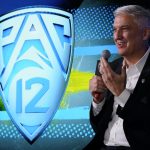Do Oregon, Washington, USC and UCLA have any chance of getting to the College Football Playoff once they enter the Big Ten, or will Michigan and Ohio State dominate? Will the Pac-12 teams regret the move over competitive reasons? — @BakerMeow
Our best guess is yes, the West Coast teams will have a decent chance to reach the 12-team CFP, and Michigan and OSU will dominate the expanded Big Ten.
First, the basic math: The ACC, Big 12, Big Ten and SEC winners will receive automatic bids, along with the highest-ranked Group of Five champion, leaving seven at-large spots each year.
Of those seven, it’s reasonable to assume the Big Ten and SEC will combine to gobble at least five and, given the selection committee’s expected emphasis on strength of schedule, perhaps six.
So let’s game out the Big Ten’s situation using an average of 3.5 playoff teams per year (the conference champion and two or three at-large teams).
Another reasonable assumption: The Wolverines and Buckeyes will take two of those bids — not every season, of course, but more often than not.
That leaves an average of 1.5 spots for Big Ten teams not located in Columbus or Ann Arbor.
Oregon, Washington, USC and UCLA will be competing with Penn State and perhaps one other team — Wisconsin one year; Iowa the next, etc. — for those remaining CFP slots.
The Hotline believes Oregon and USC are best equipped to succeed immediately in the Big Ten because of their football infrastructure, resources and, above all, the institutional commitment to winning.
Washington is thriving under coach Kalen DeBoer but, in general, lacks the football machinery found in Eugene, Los Angeles and State College, PA. Let’s place the Huskies a quarter-step behind those three in the Big Ten football food chain.
UCLA isn’t close to that group.
The Bruins haven’t won a Pac-12 title in a quarter-century and are reeling from a late-season skid under Chip Kelly, whose record in conference play over six years is just 26-26.
But it’s not just about Kelly. The Bruins have steep financial challenges, as well, with tens of millions of dollars in accumulated debt and little campus support.
Plus, UCLA likely will enter the Big Ten at a significant revenue disadvantage due, in part, to the so-called Berkeley tax.
While the University of California Board of Regents has not officially slapped the Bruins with a subsidy for Cal, our assumption is the annual figure will be closer to the ceiling ($10 million) than the floor ($2 million).
UCLA could very well generate more net revenue from the Big Ten than Washington and Oregon, which are entering the conference with half shares.
But those schools are better equipped to manage the challenge because they care more about football than UCLA. (In Oregon’s case, much more.)
In fact, the Hotline views UCLA as the single most interesting case in the realignment game that has played out over the past few years.
Are the Bruins any more equipped to win in the Big Ten (in football) than Maryland was a decade ago? At the time, the Terps were a mid-level program in the ACC with financial constraints.
(Also, UCLA chancellor Gene Block doesn’t care about football and is retiring next summer, so there’s a leadership void atop the university.)
The other notable piece of the Bruins’ move is the fate of their prized Olympic sports, which will have significant logistical and travel obstacles in the Big Ten.
USC also cherishes its Olympic sports, but the Trojans have the wherewithal to provide needed support and, oh-by-the-way, care far more about football.
Meanwhile, the Olympic sports in Eugene and Seattle don’t carry nearly the same weight within the university’s athletic culture that they do in Westwood.
Combine the value of Olympic sports with the athletic department’s financial challenges and the mediocre football program, and UCLA’s next chapter will be equally challenging and fascinating.
Will the teams that left the Pac-12 still have opportunities to play in bowl games out west? Do we know anything about the future conference tie-ins for the bowls currently aligned with the Pac-12? — @DouginTucson
That is to be determined. The bowl contracts will be reworked to accommodate realignment moves and 16-team conferences, but one thing won’t change: The desire to invite teams that make sense geographically.
The Holiday Bowl will continue to seek teams from the Pacific Time Zone; same with the LA Bowl.
Because it’s a destination for travelers coast to coast, the Las Vegas Bowl might not feel quite the same need for West Coast and Mountain region teams, but we suspect executives will favor participants from the western third of the country when possible.
With the Pac-12 breakup, bowls everywhere will have opportunities to pair teams currently in the conference against each other — Arizona against UCLA, for example, or Utah against Oregon.
However, let’s not forget that the expanded playoff will have a monumental impact on the postseason. It’s difficult to know which bowls will survive.
The opening round of the CFP will be played on the third weekend in December, with traditional bowls getting cast far into the background.
Do you expect a resolution to the Pac-12 lawsuit before Aug. 1, 2024? — @Chad_Rice
I envision a resolution by the spring, when the Pac-12 is expected to distribute the bulk of its annual revenue.
However, the current situation suggests the process could take months to play out.
The Washington Supreme Court is expected to rule today (Friday) on whether it will take the case. All signs point to a review, either by the high court in Olympia or an appellate court in Spokane.
And that review could very well drag out through the winter, even if the plaintiffs and defendants ask for an expedited process. (Which they assuredly will.)
The Hotline continues to believe a mediated settlement is the best option for all involved.
We also wonder about the financial calculation for some of the outbound schools: Arizona and Cal, for instance, are desperate for every dime of revenue because of their budget issues. But at what point do legal fees become untenable?
As always with realignment, billable hours are undefeated.
If the ‘Pac-2’ schools are so concerned about future debts, why did they not put that mid-year distribution of revenue into an escrow account to be disbursed following the case against the NCAA? — @RockDawg3
Washington State and Oregon State don’t have the authority to make that decision.
The Whitman County (Washington) Superior Court judge’s ruling in September prevents the Pac-12 board from conducting any business unless all 12 schools agree — the unanimity requirement.
Without approval from the outbound schools, the $60 million (approximate) mid-year distribution cannot move into escrow. It must remain in whatever holding account the conference uses for pass-through revenue.
What could a Pac-14 conference configuration, with Washington State, Oregon State and the Mountain West schools, reasonably expect in terms of a media rights deal? — @MarcSheehan006
That depends, in part, on the exact configuration of the new conference, and there are three options:
— The Pac-14, with the Cougars, Beavers and all 12 Mountain West schools.
— The Pac-8 or Pac-10, with the Cougars, Beavers and the top football-playing schools from the MW.
— One of the aforementioned scenarios with a select group of teams from other conferences (the AAC or CUSA, for example).
Our hunch: There will be a media rights market for whatever conference emerges in 2026.
The valuation won’t approach what WSU and OSU would have received in the existing Pac-12, but it should be substantially more than the MW schools currently generate from their deal with Fox and CBS (about $5 million annually).
Why? Because live sports rule the media marketplace, football is the king of live sports and no other college (or professional) entity will have media rights available in the second half of the decade.
Each member of the reconfigured conference should expect something in the $10 million-to-$14 million per year range, depending on the schools and the markets involved.
Do you think the Pac-12 should have added SMU and San Diego State sooner? — @mlondo856
We never understood why the conference was so insistent on securing the media deal first when it should have fortified itself through expansion. And you could argue the need to expand began back in the summer of 2021.
(The Hotline thought Houston would have been a terrific addition.)
Failing to expand was one of many strategic mistakes made over the years by Pac-12 commissioners George Kliavkoff and Larry Scott and the university presidents, who brought to the triple-whammy of arrogance, ignorance and indifference.
It’s not easy to destroy a 108-year-old college sports institution. The process requires many years and astounding levels of incompetence.
Can we get an early March Madness prediction for the Pac-12? How many bids will the conference receive, and which teams will get in? — @erwinism
The Hotline will plunge into March Madness outlook on the other side of the holidays, once conference play is underway.
But if we had to offer a prediction right now, the best guess would be four bids (one automatic and three at-large).
That’s based partly on the number of NCAA bids that have historically tracked with the Pac-12’s current non-conference winning percentage (68.5).
Arizona is a lock, of course, and we see a few more bids available for the group of teams that includes Colorado, USC, Utah, UCLA, Washington and Oregon.
*** Send suggestions, comments and tips (confidentiality guaranteed) to pac12hotline@bayareanewsgroup.
*** Follow me on Twitter: @WilnerHotline
*** Pac-12 Hotline is not endorsed or sponsored by the Pac-12 Conference, and the views expressed herein do not necessarily reflect the views of the Conference.
Related posts:

(AP Photo/Marcio Jose Sanchez)
Who’s in charge of the Pac-12? Answer unclear as the lawyers dig in
(AP Photo/Marcio Jose Sanchez)
Mailbag: Kliavkoff’s current role and final grade, options for the ‘Pac-4’ schools, the Knight view and a few words on our coverage
(AP Photo/Ralph Freso, File)
What’s next for the ‘Pac-2’: Could Washington State, Oregon State attempt a reverse merger with the Mountain West?
Washington State quarterback Cameron Ward (1) (AP Photo/Young Kwak)
Heisman Watch: Penix on top, Ward and Nix riseJon Wilner
Jon Wilner has been covering college sports for decades and is an AP top-25 football and basketball voter as well as a Heisman Trophy voter. He was named Beat Writer of the Year in 2013 by the Football Writers Association of America for his coverage of the Pac-12, won first place for feature writing in 2016 in the Associated Press Sports Editors writing contest and is a five-time APSE honoree.
